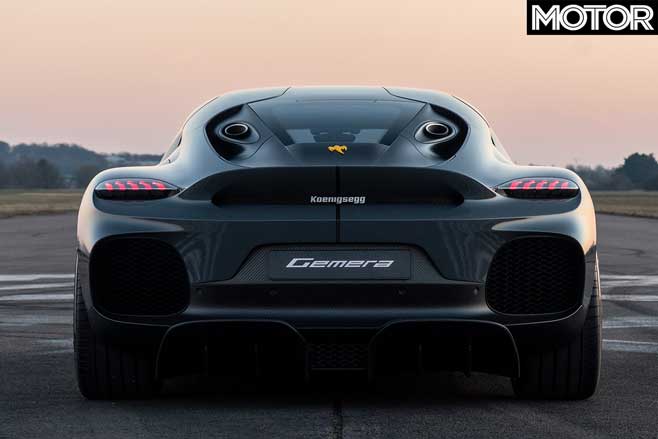Koenigsegg was one of the last brands we would expect to knock off Mercedes-AMG with the most powerful 2.0-litre engine in the world. But after releasing its new USD$1.7m (AUD$2.6m excluding taxes) Gemera to an empty motor show in Geneva in March, the four-seat hybrid hypercar quickly proved it is a mould-breaker in more ways than one.
For instance, the mid-mounted 2.0-litre three-cylinder engine (yes, three cylinders) drives only its front wheels, and it will be the first in the market to feature camshaft-less valvetrain technology. And the company says that, with three electric motors supplementing its grunt, Gemera will be the first hybrid (and four-seater) to reach 400km/h.
These achievements are yet more impressive when you consider they all come from one car. But company founder and CEO Christian von Koenigsegg built Gemera to show the world his take on the best solution for shrinking emissions from long-range car travel – until battery technology gets its act together for pure EVs.

As well as producing as much as 1268kW and 3500Nm from its hybrid powertrain, Koenigsegg claims the Gemera can travel 50km on electric power alone and as far as 1000km when starting out with a full charge and fuel tank. That’s a drastic gap to Croatian EV hypercar firm Rimac, which plans to squeeze only 550km of range from its incoming full electric C-Two hypercar.
Of course, the Gemera’s eco-credentials are moot as long as it’s sipping fossil fuels and plugged into a coal-powered wall outlet. But Koenigsegg has an answer to that. It’s called the TFG, which is a quaint name for its engine and stands for Tiny Friendly Giant.
Koenigsegg explains its compact size allows the Gemera to fit the engine behind the rear seats while still leaving room for three “full-size” carry-on bags. Crucially, it says to achieve the Gemera’s figures with a full-electric powertrain would add another 30 per cent in weight to account for larger batteries and other hardware. All up, the carbonfibre-chassis Gemera weighs 1850kg at kerb, or within 40kg of a Camaro ZL1.

Okay, but why ‘friendly’? Well, to keep on the previous point, a lighter kerb weight benefits handling as well as easing its demand on consumables. And then there’s the TFG’s camshaft-less valvetrain, developed by Koenigsegg subsidiary Freevalve, that allows it to run on “whatever you can find”, including petrol and even diesel in small amounts.
What it’s really designed for, though, are “next generation renewable” biofuels – like Gen 2.0 Ethanol and Vulcanol – that virtually neutralise tailpipe emissions thanks to ‘extreme’ catalytic converters. On top of this, the TFG also charges the batteries when you’re on the move.
Finally, the ‘giant’ tag comes from the fact it accounts for 447kW and 600Nm of the Gemera’s total outputs, thanks to a twin turbocharging system that relies on Freevalve to control the sequential nature of its arrangement.

But the stars of the show are really the Gemera’s electric motors. The least of them sits in front of the TFG on the crankshaft. Rated at 298kW/400Nm, it assists the ICE to drive the front wheels through a torque tube. The other two straddle the TFG and drive each rear wheel directly. They’re rated at 373kW and 1000Nm each and can be decoupled via wet clutch for torque vectoring or range. All up, the three motors make a combination of 1044kW and 2500Nm while feeding on an 800-volt battery.
Gemera will hit 400km/h without a single gearshift. With its monstrous 3500Nm torque peak arriving before 2000rpm, the car simply pulls through a single ratio all the way to its top speed – while clipping 100km/h from rest in just 1.9sec.
So, the Gemera boasts mega grunt, ridiculous speed and enough room for your family and guilty conscience. Like we said, it’s a mould-breaker.
Koenigsegg Gemera’s Hybrid System

01 | Locked or Unloaded The engine’s power arrives at a front differential, which is flanked by two hydraulic clutches. They lock up to offer torque vectoring to either front wheel, and can disconnect to save fuel in EV mode.
02 | Carbon Castle The battery is rated at 800V and 16.6kWh. It lives under the front occupants in a carbonfibre casing and carbon-aramid tunnel down the centre of the car. Koenigsegg says it is liquid-cooled and each cell carefully monitored.
03 | Mighty Mouse The dry-sumped 2000cc three-banger weighs only 70kg and is no bigger than a carry-on suitcase. But each cylinder is big, sporting a 95mm bore and 93.5mm stroke. The TFG at its 8500rpm redline equals F1 engine piston speeds.
04 | Double the Fun Grunt has to pass through a hydraulic coupling before reaching the front diff. It can double the torque while under 3000rpm, explaining why the Gemera makes 3500Nm in total, even though its powertrain makes 3100Nm combined.
05 | Twin Turbo Each cylinder has two exhaust valves, with one routed to a smaller turbocharger and another to a higher-flow one, and the infinitely adjustable valves can direct gases to whichever turbo unit required for the rpm range.
06 | To Infinity! Pneumatic actuators replace camshafts, offering infinitely variable valve timing – and also doing away with the need for throttle bodies. It’s so complicated only artificial intelligence will ever be able to get the best out of it.
Styling? Inspired by an egg, mate

At just under five metres long it would seem like the Koenigsegg Gemera’s goal to cram four people in a mid-engine car has been achieved. Koenigsegg says the cabin, inspired by the shape of an egg, can fit four adults each over 6’5 in height. The front seats don’t even need to be moved to enter the rear. Enormous single ‘dihedral synchro-helix’ doors doors span each side. They swing up and forward, keeping out of harm’s way thanks to sensors located along the doors’ edges.






